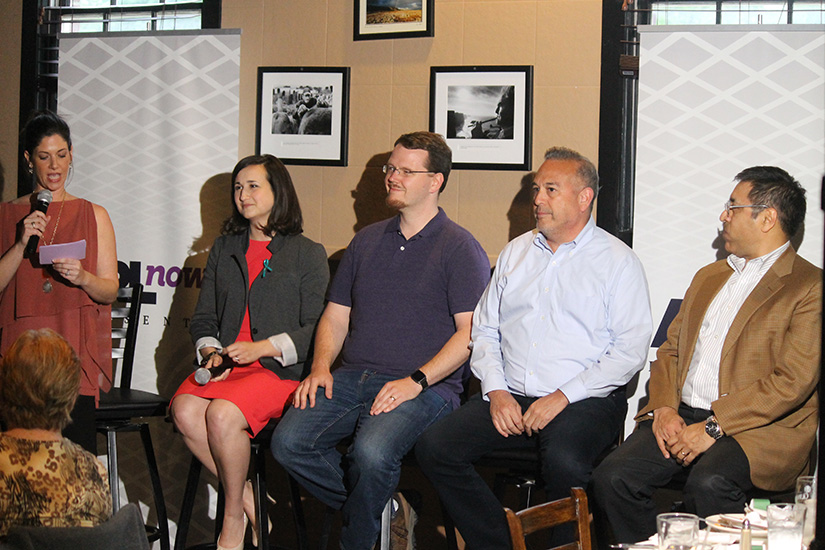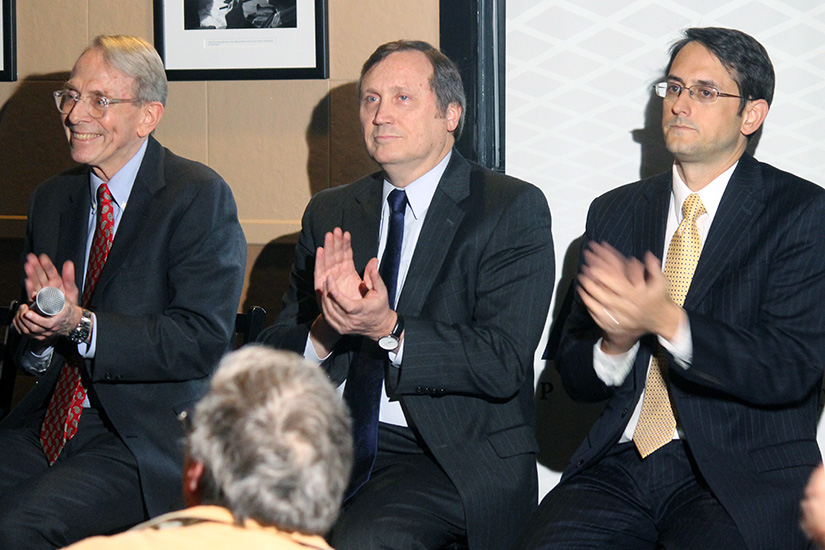(Updated at 2:46 p.m.) What happened to the Columbia Pike Streetcar project? What can be done about crowded local schools? How can we incorporate affordable housing and public amenities into future development?
These were just a few questions answered during last night’s ARLnow Presents: Hot Topics on the Pike discussion at the Celtic House Irish Pub (2500 Columbia Pike).
The first half of the night was filled by a discussion among our opinion columnists — Mark Kelly (The Right Note), Peter Rousselot (Peter’s Take) and Larry Roberts (Progressive Voice) — on countywide issues.
The first question of that discussion, asked by host Amanda Fischer, was whether the columnists felt like the streetcar project’s cancellation was the right decision and what the county’s biggest transit priorities should be in 2016.
“I believe the cancellation of the streetcar was the right decision,” Rousselot said. “[The] most important one coming for Arlington is the Columbia Pike corridor and premium bus service.”
“On the regional level, this was going to be connected to other projects,” Roberts said. “[If you go to the] Pearl District in Portland, you will see everything that could have been in Columbia Pike.”
Kelly said the project, overall, had a “common sense problem,” and added that he was “pleased” when the project got the ax.
He added that he thought the county’s number one transit priority should be exerting its influence “to get to real reforms for Metro.”
Next question: Should the Long Bridge Park aquatics center be built?
“I believe it should be built,” Roberts said. “The aquatics center is needed.”
Kelly answered that he’d take “a wait and see attitude on the new version of the aquatics center.”
“They would need to build a new swimming facility,” he added. “I’d like to see more details before jumping on one side or the other.”
Rousselot differed from his fellow columnists by proposing some big changes to the plan. He said he’s like to see the county “eliminate the 25 [yard] pool, take the money… and potentially reinvest that money in another community pool and fitness facility in South Arlington so you could get two.”
“Look very seriously at taking a portion of the money and reinvesting it in a community pool… closer to where we are here tonight on Columbia Pike,” he added.
The columnists also tackled the contentious issue of shifting area demographics and what that means for the burgeoning enrollment at Arlington Public Schools, which is projected to continue growing in the coming decade.
“I think our schools have done a pretty good job and they’re attracting people,” Kelly said. “We might get to a point where we have to add one or two kids per classroom and that’s going to be a tough sell for school board members to have to take that vote.”
Rousselot said he thought the school board should reexamine its enrollment projections.
“I believe that there’s a potential with some good coordination with the county board to work further to refine the demographic expectations,” he said.
For Roberts, the “problem” of skyrocketing school enrollment isn’t necessarily a bad sign.
“We created excellent, dynamic schools,” he said. “It makes it a very attractive system for people moving into the county. In that sense, school board members current and past should be applauded.”
“As we look forward, the most important thing we can do right now is to have strong cooperation between the school board and the county board,” Roberts added. “The schools need county board resources. The county board also needs to look at the schools as a huge priority. We just don’t have enough room to build our way out of this problem.”
Later in the evening, County Board member Katie Cristol, Arlington County Transportation Commission Chair Chris Slatt, Columbia Pike Revitalization Organization Chair John Murphy and small business owner Michael “Mike on the Pike” Garcia took the stage to talk about the future of Columbia Pike.
First up: What killed the streetcar project and how bad was it for Columbia Pike?
“My position on the streetcar is, forward, what’s next?” Cristol said as she advocated for better premium bus service and “one-seat rides” along the Pike.
In one of the evening’s more pointed moments of disagreement, Murphy said he was slightly skeptical of plans for a “fancy bus” service.
“Are we really going to see it? Who’s going to pay for it? How is it going to work? I won’t believe it until I see the first bus rolling down the street,” Murphy said.
He added that many of the businesses along the Pike were hoping for a boost from the streetcar. Garcia agreed.
“Just like that, it was taken away,” Garcia said. “We have to have some healing.”
Despite past scars over the streetcar project, the panelists were hopeful for the future of Columbia Pike.
“I don’t think the Pike’s future is dark,” Slatt said. “I think there’s plenty that people can do to make this a place that people want to invest in.”
“I think if we can get transit right on Columbia Pike… we will see the transformation that a lot of people have been hoping for for so long,” he added.
Murphy agreed that a new transportation plan was needed to jumpstart development along the Pike.
“Our first floor retail is dying,” he said. “None of it is going to get better until we actually see a new transportation plan here.”
For Cristol, one way to reinvigorate the local economy could be to add more public amenities. She argued that development along the Pike could bring with it not only density, but also more “great public spaces.”
“We have a sense of… protecting not only our neighbors who need affordable housing, but our commercial interests who need affordable rents,” she said.
“The real struggle of Pike businesses right now is that you’re stuck in the awkward teenage years of the transformation of the Pike,” Slatt said. “Some of the new development has come in, so the rents are very high, but not all of the new development has come in so you haven’t created a walkable main street.”
When asked about affordable housing, all of the panelists agreed that housing had to become more affordable one way or another.
“The kind of person that says, affordable housing, ew, they’re operating on a bad misconception,” Murphy said. “Any investment in new housing on the Pike serves us all well.”
“Affordability is [also] actually related to our school capacity growth,” Cristol added. “When housing gets too expensive, when your rent rises, one of the strategies people adopt is doubling up.”
Additionally, she argued that families spending 50-60 percent of their income on rent wouldn’t be able to effectively participate in the local economy.
“Having people who can sustainably live on the Pike and participate in the retail… really is the path forward to a sustainable future.”
Then, to the final question: What might Columbia Pike look like in 2040?
“I have two words,” Murphy said. “Affordable Clarendon.”
Garcia said he “would predict that we would have a monorail on the Pike as the next form of transportation,” and “hopefully just as diverse, just as vibrant of a community.”
Cristol painted a picture of a Columbia Pike that had simple, easy-to-use premium buses. “I’m picturing walking out of my house, walking up the Pike and getting on a beautifully marked… premium bus service,” she said. “[And] a lunchtime crowd from the Pentagon. Office workers to support our retail. I’m hoping for… room for everyone.”
Though Slatt said the future is always hard to predict, he said he’d like to see a more walkable, bike-friendly Columbia Pike.
“I’d like to see a Columbia Pike where you can move about however you want,” he said. “Where you can walk safely… where you can bike safely. Where you can get on a bus that will take you to every Metro line that exists.”
Arlington Independent Media filmed the evening’s proceedings. Look for the full video to be published here in the coming weeks and to be broadcast on Comcast channel 69 or Verizon channel 38.



